The third supporting question, “How did communities build an education system?” identifies a specific type of social infrastructure system that is nearly universal. One of the first institutions to appear in even the most rural of communities was a local school system. The most rural of places was organized by township, which set aside a section of land for a one-room schoolhouse, ensuring all children had access to some level of education. Even early on in the state’s history, North Dakota schools dealt with the challenge of consolidation. The following sources provide a case study for what that looked like in one part of the state.
North Dakota is a large state of 70,704 square miles with a small population which peaked in 1930 at 680,845 people and then entered a steady decline to about 642,000 people in 2000. Though many North Dakotans enjoy the wide-open spaces, the lack of highway traffic, and the sense that we all know each other, the combination of great space and small population sets up a series of difficult problems for school districts. Since the first school consolidation law was passed in 1910 encouraging school districts to re-organize and bring several small schools together under one roof, the state legislature, county and city commissioners, and school districts have tried to find a solution to providing an excellent education to students in rural areas and small towns without taxing the residents beyond their ability to pay.
The first school in the northern part of Dakota Territory opened in Bismarck in 1873. By the time North Dakota became a state in 1889 there were public high schools in Bismarck (1873) Grand Forks (1882), Fargo (1882), and Minot (1887). Though the state had a system for certifying teachers, most teachers were young women, often teenagers themselves, with little education or experience. The state and school districts worked to professionalize the field and required increasing levels of advanced education for teachers. By the end of the 1920s, only 1% of teachers lacked a high school diploma. Parents saw the value of education for their children, too. Public school attendance reached a high point in 1923 with 176,000 students. However, few of those 1923 students attended or graduated high school, and even fewer went to college. Through the 1930s, more female students enrolled in school and graduated high school than male students, which may reflect the value that boys had as farm laborers.
The school situation became quite bleak in the early 1930s when the Great Depression led to reduced property tax collections (which support schools), and school boards reduced teachers’ salaries. Even though school attendance and high school graduation rates rose in the 1930s, rural schools lost necessary funding and underwent a period of consolidation to reduce the cost of building maintenance, teachers’ salaries, and other school expenses. The Depression left North Dakota schools with a teacher shortage that forced school districts to hire poorly prepared teachers for many more years.
The hardships of the Great Depression ultimately led to a startling statistic of the Korean War era: 13% of North Dakota’s Army draftees failed the standard test known as the Armed Forces Qualification test. In the 1951–1952 schoolyear, there were 2697 rural schoolteachers in North Dakota. Twenty per cent of these were not certified, and 15% had not attended college at all. More than half the rural teachers had one year or less of college studies.
Over the next fifty years, North Dakota instituted higher qualifications for teachers, but school consolidation continued to be seen as an important part of the process of improving North Dakota’s educational system. School administrators and scholars assumed that rural one-room schools were the “weakest link in the education system” and that town schools were too small to “carry out an efficient well-rounded program of education.” Though consolidation sometimes created discord among neighboring communities, it resulted in improved school resources for more students and reduced the number of one-room schools to eight by 2005.
This document set includes a case study of the challenges facing Divide County schools which led to the formation of a single county school district in the early 1960s.
Sources:
Educational Achievement in North Dakota City, Town and Rural Schools by Robert D. Cole (Departmental Bulletin of the University of North Dakota, Vol. XV April 1931, No. 2).
North Dakota Blue Book, 1997
State of North Dakota. 26th Annual Report of the Director of Secondary Education 1933. SHSND Series 130101.
55th Annual Report of the Director of Secondary Education of the Superintendent of Public Instruction for the year ending Jun 30, 1962. SHSND Series 130101.
Robert D. Cole, Educational Achievement in North Dakota City, Town and Rural Schools (Departmental Bulletin of the University of North Dakota, Vol. XV April 1931, No. 2).
Cecile Wehrman, Editor, The Journal, Crosby, ND.
Complete the following task using the sources provided to build a context of the time period and topic being examined.
Formative Performance Task 3
Use the information from Featured Sources A-Z to describe the role of the education system in community development. What impact did consolidation have on urban and rural schools? Using data provided in the charts and the other featured sources, develop an explanatory answer for each of the following questions. Students in rural schools scored poorly on the standardized tests administered in 1929. What do these scores tell us about rural education in 1929? What other evidence supports your conclusion? Are there other factors to be considered that educators and researchers have not considered? Examine the architect’s drawings of Fortuna Elementary School. How does the building relate to the education and activities of Fortuna’s students? What does this drawing tell us about the Fortuna’s’ vision of the future of their town? Create a graphic organizer that depicts what life is like on reservations for Native American people today.
Featured Sources 3
Study featured sources A-S. In a group or as a class, answer the following questions: What type of sources are they (letters, photos, maps, diaries, etc.)? What kind of information do they contain? Who created each of these sources? Who was the intended audience for each source? Why were these sources created? When were the sources created? How do we know? What else can you find?
Elementary Schools
The small towns of Fortuna and Ambrose can be used to demonstrate the history of Divide County elementary schools. Fortuna was founded in 1913, and by 1915 when the school opened, the town was a bustling economic center with a newspaper, post office, lumber yard, grain elevator, barbershop, hardware store, pool room, and a movie theatre. It had a fire department with two new trucks. School attendance was required of all school-age children, and bus service extended two and one-half miles beyond the city limits to bring nearby rural children to the town school. Children who enrolled at Fortuna in 1915 had previously attended one of three rural one-room schools. One of those rural schoolteachers, Mrs. Agnes Harden became the Fortuna teacher in 1915. The Fortuna grade school offered programs similar to those of larger town schools. Mrs. Harden purchased an Edison phonograph so the children could listen to music. Students competed in spelling contests and in 1929 formed a chapter of the Young Citizens’ League, a popular school organization focused on citizenship. The school added electric lights in 1927. In August 1951, Fortuna received a boost to its economy and school enrollment when the Fortuna Air Force Station (AFS) opened five miles west of town. This radar base employed about 150 people until it closed in 1979. The Fortuna school burned down in 1956, but the community re-built, and the new school opened in 1958 boasting of “sewer and water facilities.” In 1964, Fortuna built an addition to its grade school which included four more classrooms, a gym, a stage for band and other performances, and a kitchen. The grade school closed in 1986 and students are now bussed to Crosby.
Ambrose School District began with a sod schoolhouse three miles west of town in 1906. With growth typical of the early 20th century, Ambrose built a town school in 1908, quickly outgrew it, and built a new two-story brick schoolhouse in 1912 at a cost of $16,000 which housed both the elementary and high schools. It had three classrooms, a study hall, and a basement playroom. A library was established at the end of one hallway. As enrollment grew, the school turned part of the basement into a classroom. In 1922, donating labor, equipment, and supplies, the people of Ambrose built an underground gymnasium to support their basketball team.
Small town schools faced problems such as adequate financing, student transportation, locating and retaining qualified teachers. In addition, the use of standardized tests in the 1920s indicated that elementary students in rural and town schools scored significantly lower than the national standard score. Though rural and small-town schools had some important advantages, students in these schools lacked some of the skills valued by urban educators.
Source: Cecile Wehrman, Editor, The Journal, Crosby, ND
Crosby Diamond Jubilee, 1904-1979
High Schools
In a special, county-wide election conducted February 15, 1962, Divide County voted 4 to 1 to consolidate all its schools into a single school district. Voters accepted the concept of a single county school district to “equalize educational opportunity,” and to “equalize taxes.” Fortuna, Ambrose, and Alkabo high schools closed in 1962 and thereafter students rode the bus to Crosby. Noonan and Crosby high schools, the only accredited high schools in the county remained open, “for now.”
Ambrose High School was a Class 3 high school for many years, though it held Class 2 status in 1931. The high school employed about three teachers who taught a wide range of subjects. One of the teachers was also principal, and one was also school superintendent. Like many other Class 3 high schools, Ambrose had a low percentage (16% in 1932) of its students go on to college or trade school. The high school was classified as a Graded and Consolidated school in 1961 and closed in 1962. Ambrose students enrolled at Crosby in the newly organized Divide County District 1 high school.
Noonan High School was another Class 3 high school in located in eastern Divide County. Noonan High became an approved school in 1919. Though it managed to hold onto its school population for many years, students were bussed to Divide County High School for some classes for several years after 1962 until the school finally closed in 1981.
Crosby High School was approved and accredited in 1918. It had a larger student body than other Divide County high schools which may be related to the fact that Crosby is the county seat. In 1962, when Divide County schools consolidated, Crosby was designated the site for both high school and grade school. In the fall term of 1962, Crosby high school enrolled an extra 50 students from the three high schools that closed in June 1962.
Sources:
State of North Dakota. 26th Annual Report of the Director of Secondary Education 1933. SHSND Series 130101.
55th Annual Report of the Director of Secondary Education of the Superintendent of Public Instruction for the year ending Jun 30, 1962. SHSND Series 130101.
Divide County Journal, November 22, 1961; November 29, 1961; February 22, 1962.
Data Tables
Tables 1 through 5 have been compiled from data recorded in the Report of the Director of Secondary Education for the years 1932 and 1962. Tables 1 through 3 offer some basic information on Divide County High Schools. Tables 4 and 5 provide data on schools statewide and in North Dakota’s biggest city, Fargo, for 1932 and 1962 for comparison with Divide County schools.
| Source A |
Table 1. General Population and Student Population of Divide County
* Actual year of count is given in parentheses.
|
||||||||||||||||||||||||||||||||||||||||||
| Source B |
Table 2. Divide County High Schools, 1931-1932
* Crosby was fully accredited since 1918. Noonan became an approved high school in 1919. Ambrose was a Class 2 consolidated school until 1931 when it was reduced to Class 3.
|
||||||||||||||||||||||||||||||||||||||||||
| Source C |
Table 3. Divide County High Schools, 1961-1962
* Ambrose closed its high school in 1962 at the end of the school year. Noonan also closed its school in 1962
|
||||||||||||||||||||||||||||||||||||||||||
| Source D |
Table 4. North Dakota and Fargo [1] high school data, 1933.
[1] Fargo High School is used as a comparison because it was the largest city high school in the state. [2] State schools were ranked in a numerical system of Class 1, Class 2, and Class 3. There were also some schools identified as Consolidated and Ungraded. The highest-ranking schools were Class 1 such as Fargo and Crosby. Though Ambrose was a Class 2 high school in 1931, most state records list it among the third-class high schools. Noonan was a Class 3 high school in most records dating from the 1930s. Fortuna High School does not appear in state high school records for 1933 or 1962. [3] In 1931, fewer students entering high school graduated than any other year in the twentieth century. This low rate was somewhat related to the Great Depression. However, soon parents understood that high school education offered an advantage in times of economic hardship, and the graduation rate began to rise again. High school graduation increased in 1932 by 259 students over 1931, and college attendance increased by one percent. |
||||||||||||||||||||||||||||||||||||||||||
| Source E |
Table 5. North Dakota and Fargo high school data, 1962. *
* Fargo high school data is for all public-school students. State figures are for both accredited and non-accredited schools.
|
Inspector Reports
In the early 20th century, school reports were compiled by school inspectors who showed up without advance notice. They gathered data on the schools which helped the Superintendent of Public Instruction to understand how well the school district provided for its students. The information gathered by the report was numerical: numbers of students, faculty, etc. There is little information on the courses studied or the quality of instruction. These documents, one for Crosby School in 1912, the other for Fortuna School in 1918 give a small snapshot of school conditions during that school year. Source: Department of Public Instruction Graded School Reports, SHSND Series No. 31178.
| Source F |
Crosby Inspection 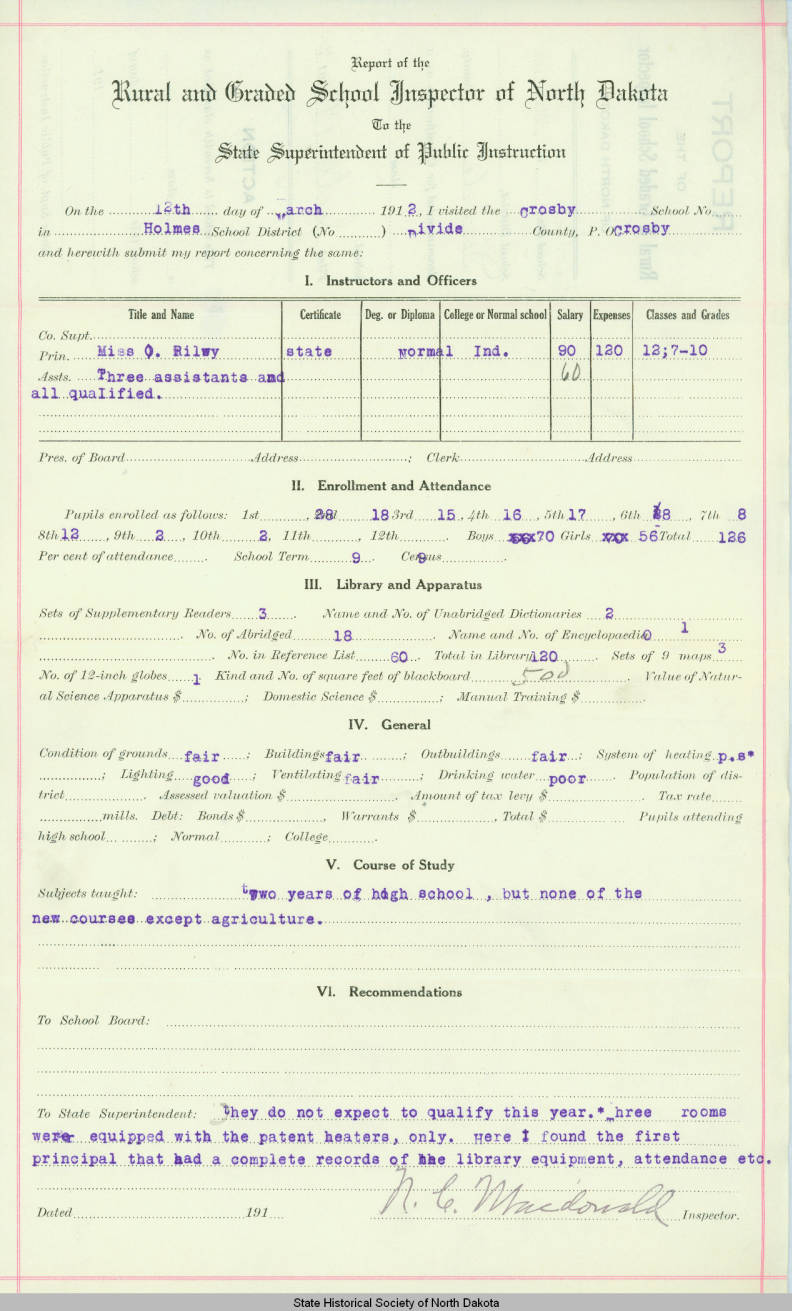
http://www.digitalhorizonsonline.org/digital/collection/uw-ndshs/id/3745 |
| Source G |
Fortuna Inspection 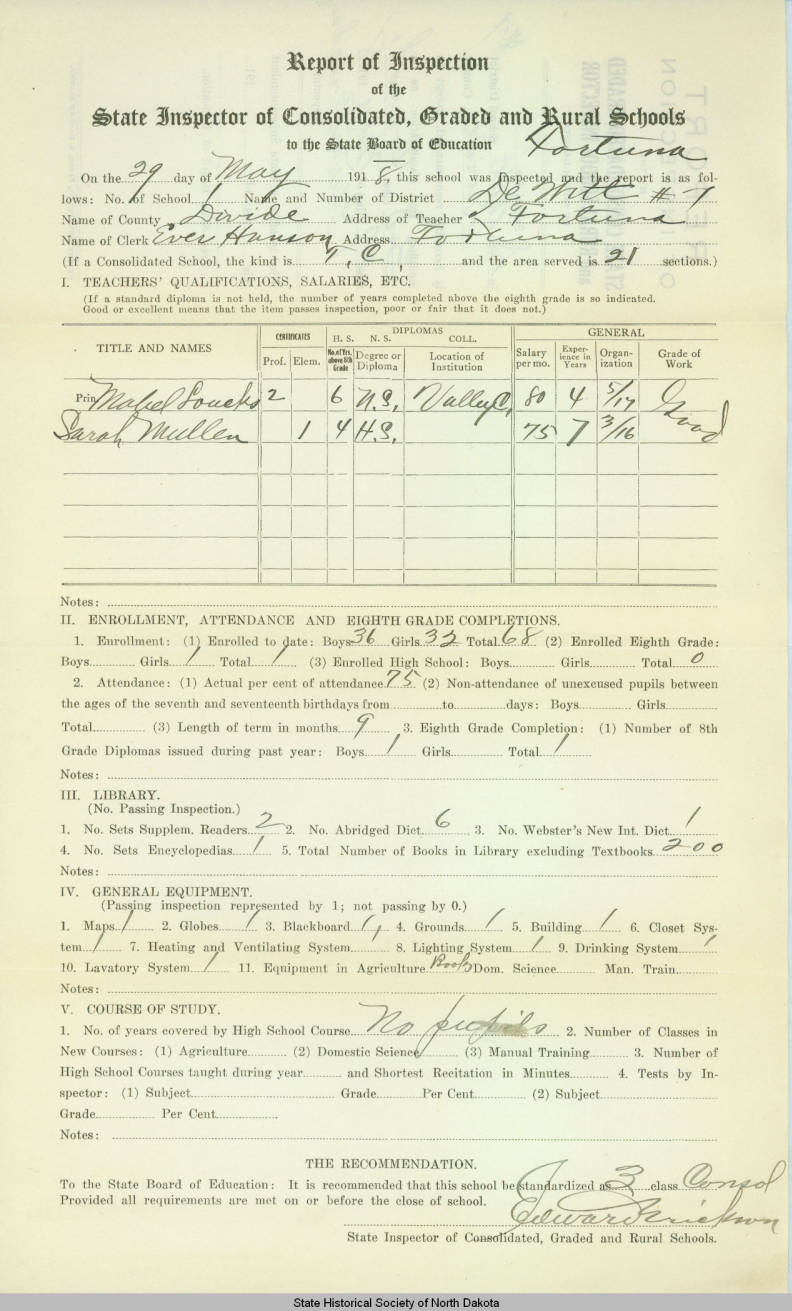
http://www.digitalhorizonsonline.org/digital/collection/uw-ndshs/id/3746 |
Consolidation Maps
Source: Norman H. Hanson, History of Consolidated Schools in North Dakota. MS Thesis, University of North Dakota, 1946.
| Source H |
1910 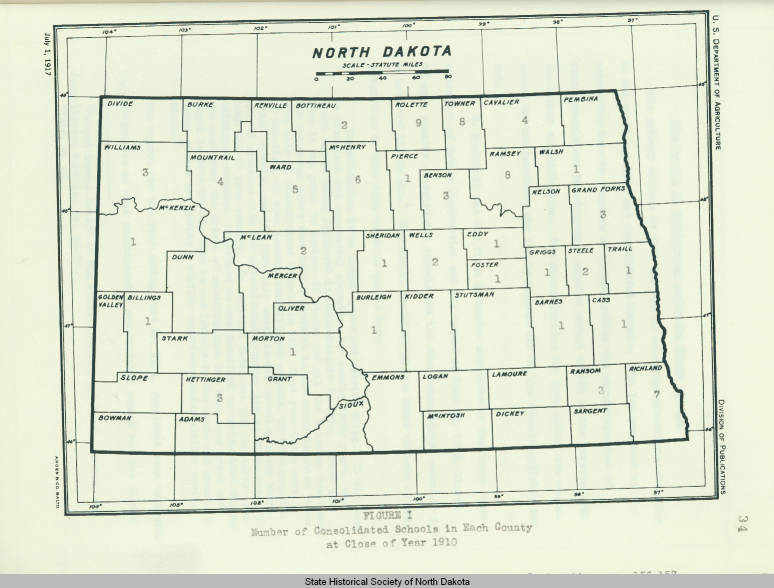
This map shows the number of consolidated schools in each county in 1910. Note that several counties, including Divide County, had no consolidated schools. http://www.digitalhorizonsonline.org/digital/collection/uw-ndshs/id/3771 |
| Source I |
1917-1918 School Year 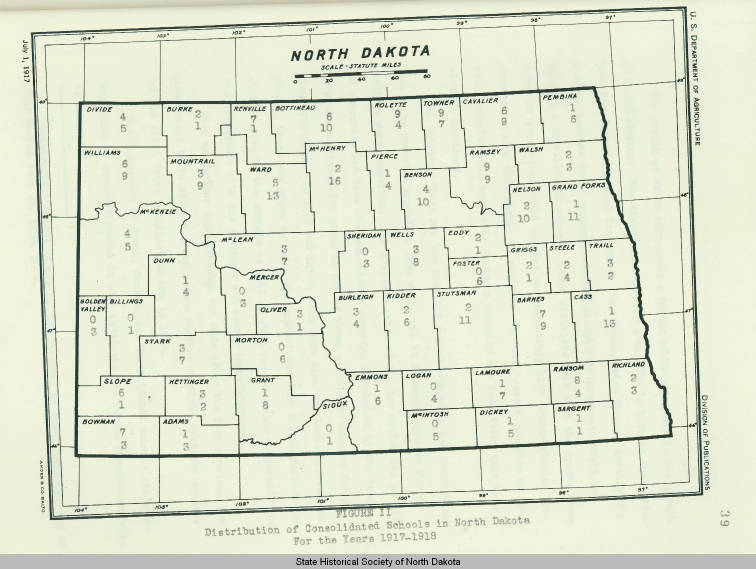
This map shows the number of consolidated schools in each county for the 1917-1918 school year. The top number is rural consolidated schools. The bottom number is for the number of consolidated schools in towns. Every county has some consolidated schools by this time. http://www.digitalhorizonsonline.org/digital/collection/uw-ndshs/id/3772 |
Stanford Test
North Dakota began to use standardized tests in 1929. The Stanford Achievement test allowed students to be compared in their class, their grade across the state, and to students of the same age around the nation. Theoretically, the standardized test eliminated teachers’ subjective scoring of their own classroom examinations, allowing educators to make comparisons that demonstrated the quality of instruction and learning in all schools. The questions were designed considering the newest scholarship. Test questions were constructed so that some questions could be answered by all students, but other questions tested the ability of the best students who had advanced in their education. Scholars acknowledged that standardized tests had serious limitations. They measured factual knowledge and skills but were not a good measurement of reasoning. There was also the danger that teachers would design their lessons to raise test scores. The scores, test administrators cautioned, did not correlate to norms that were absolute in defining success or failure of a school, but were arbitrary and only useful as a value to be compared to other schools.
In North Dakota, test administrators checked individual test items against the North Dakota Elementary Course of Study. The Literature Test was the only one of 10 tests that did not correlate well with the North Dakota course of study in literature. There were 80 questions on the literature test; only 17 could be found in the North Dakota Course of Study for Elementary Grades. Seven more questions were based on the Bible, but the answers to these questions were not covered in the usual coursework. Ten questions were based on literature studies assigned to ninth grade students. The remaining 46 questions not specifically found in the course of study “might or might not be included in the work done in school.” (p. 10) It is not surprising, therefore, that North Dakota students did not do well on the Literature Test.
Source: Robert D. Cole, Educational Achievement in North Dakota City, Town and Rural Schools, Departmental Bulletin of the University of North Dakota Vol. XV, April 1931, No. 2.
| Source J |
1910 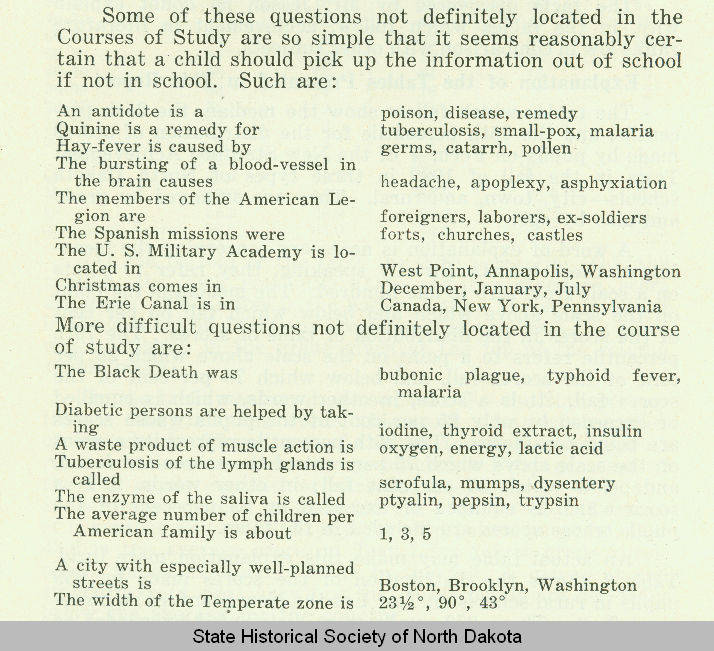
http://www.digitalhorizonsonline.org/digital/collection/uw-ndshs/id/3748 |
| Source K |
Table 1 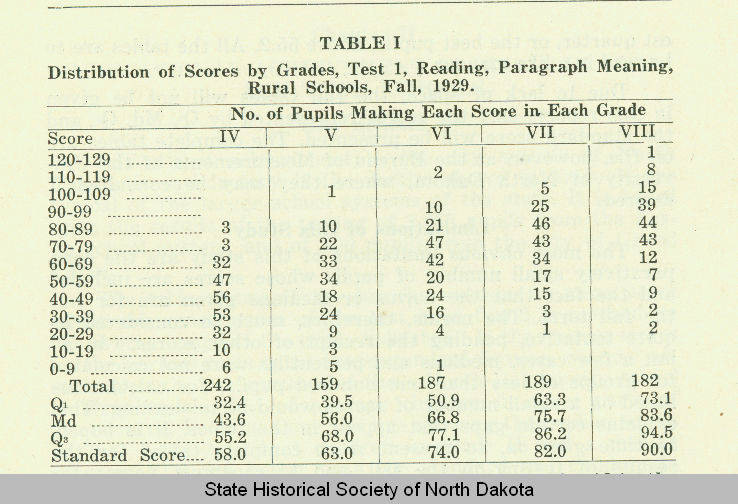
Table I gives only total scores for rural students in grades 4 through 8. For instance, 242 fourth grade students took the test. The median (Md) score of 43.6 was 14.4 points lower than the national median score. http://www.digitalhorizonsonline.org/digital/collection/uw-ndshs/id/3749 |
| Source L |
Table 3 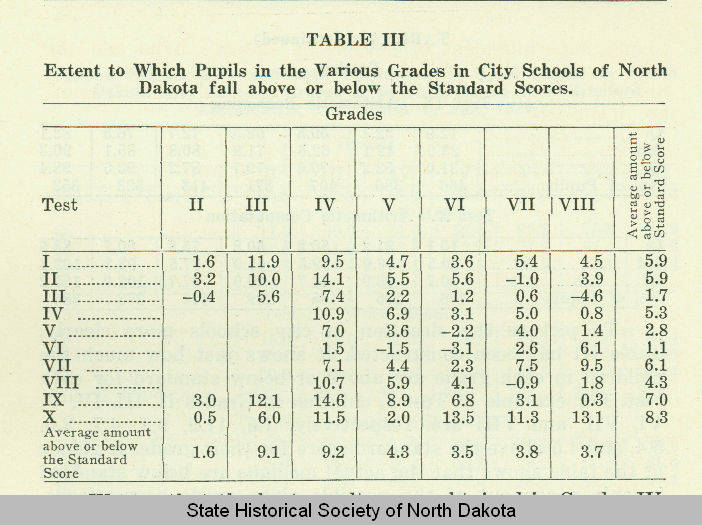
Table III shows the scores achieved on each test (left hand column) by all the students in each grade (II through VIII) who sat for the test in North Dakota’s cities. All of the averages are above the national standard. http://www.digitalhorizonsonline.org/digital/collection/uw-ndshs/id/3750 |
| Source M |
Table 5 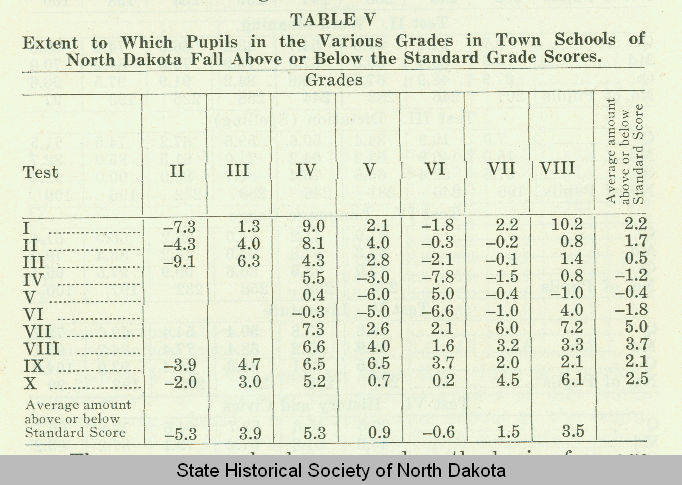
Table V shows the scores achieved on each test (left hand column) by all the students in each grade (II through VIII) who sat for the test in North Dakota’s towns. The averages are close to the national standards, but a few fall below. The tests topics are numbered as follows:
http://www.digitalhorizonsonline.org/digital/collection/uw-ndshs/id/3751 |
Architect’s Plan
In 1964, Fortuna built a new grade school. The architect’s drawings for the addition to the Fortuna school, 1964, show not only additional space and classrooms, but label the space with the kinds of activities the students would pursue in the new school.
| Source O |
Fortuna School Addition Blueprint 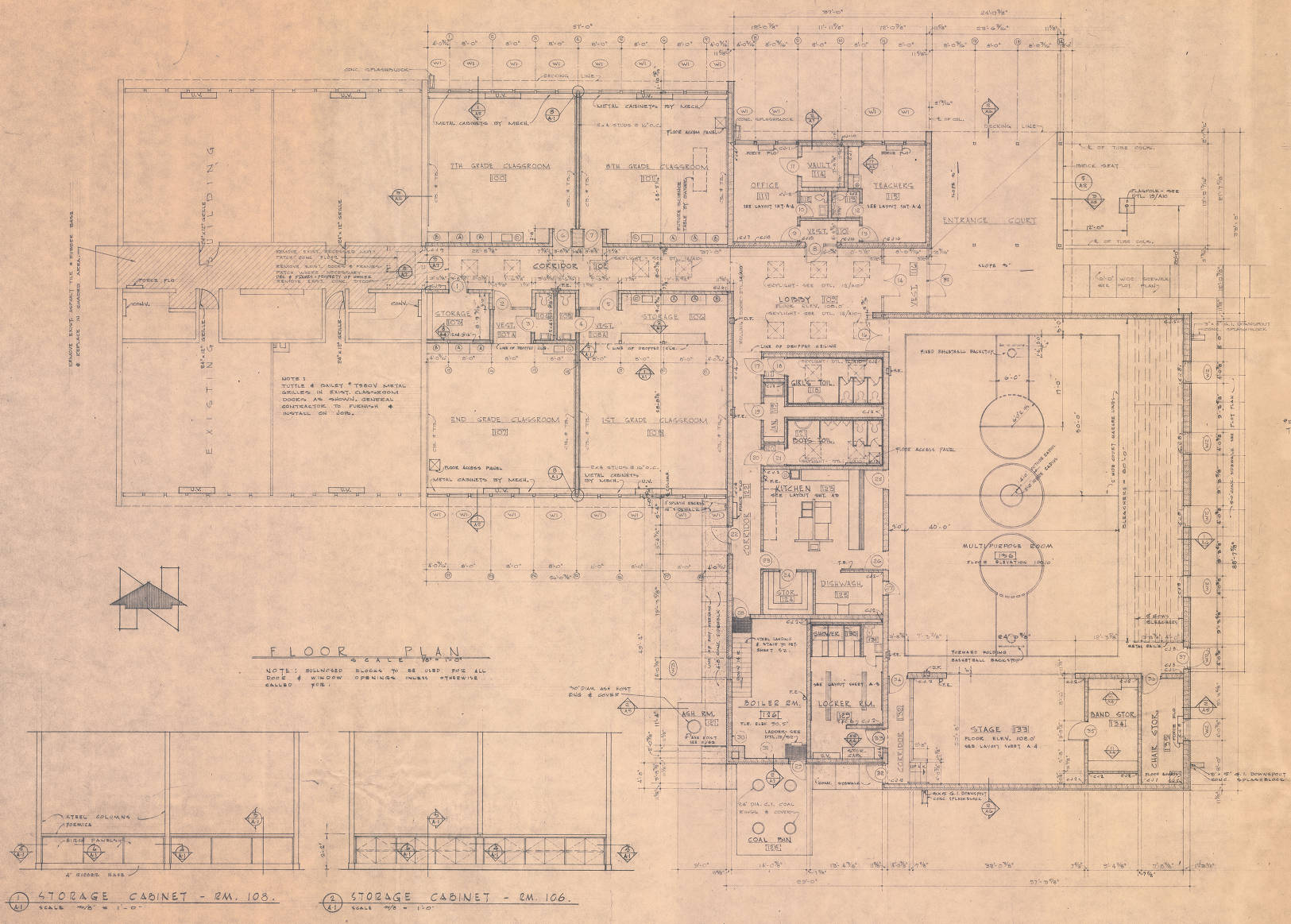
Source: SHSND, uncatalogued collection. http://www.digitalhorizonsonline.org/digital/collection/uw-ndshs/id/3784 |
Photographs
| Source P | 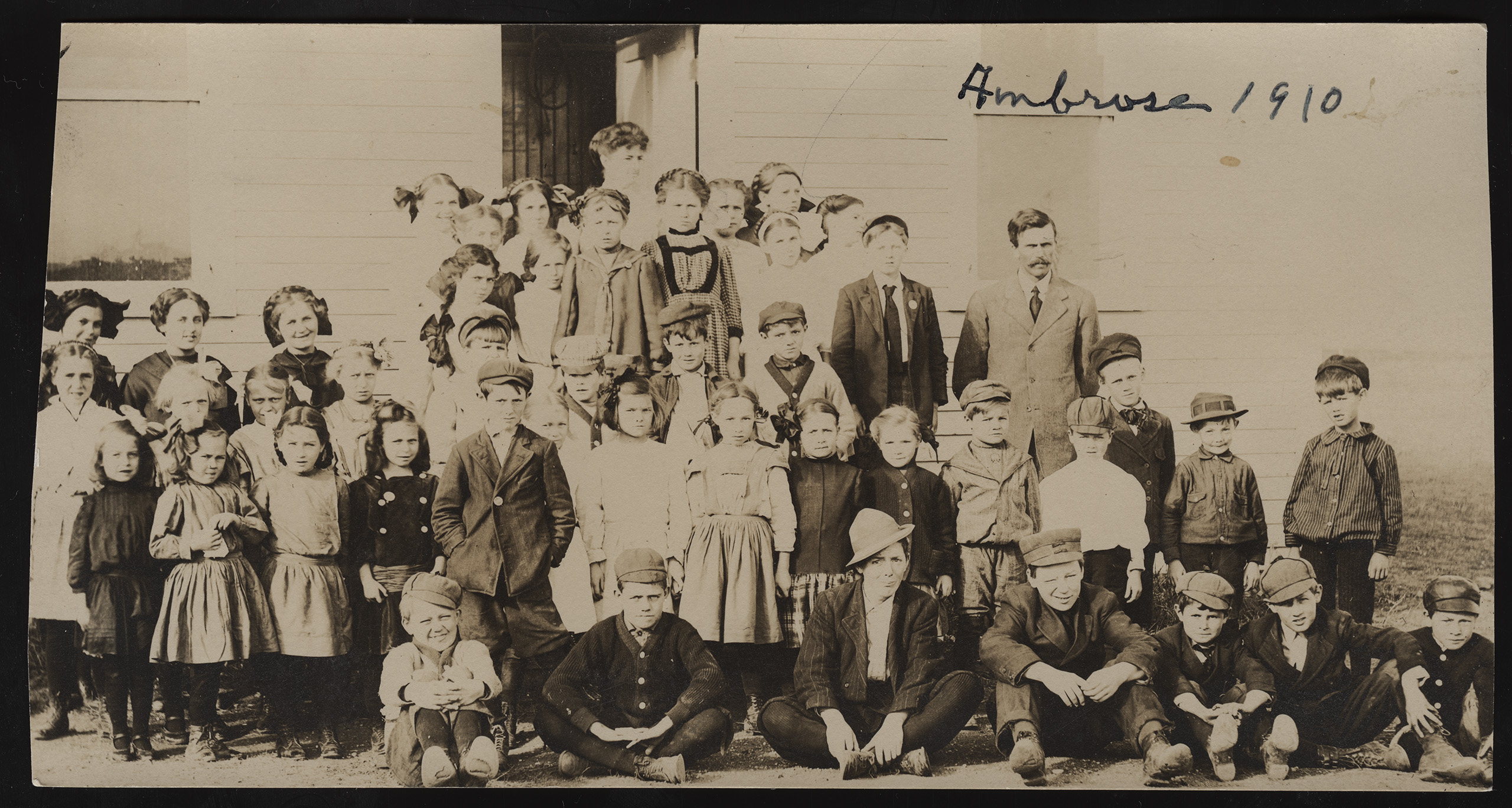
Of the 45 students posing for this Ambrose school picture in 1910, only 16 are boys. The woman teacher is at the back in the schoolhouse doorway. The man on the right may be another teacher or the school superintendent. The children range in age from about 5 (front row standing, left) to the early teens (front row, seated). SHSND: 2018-P-076-00038. |
| Source Q | 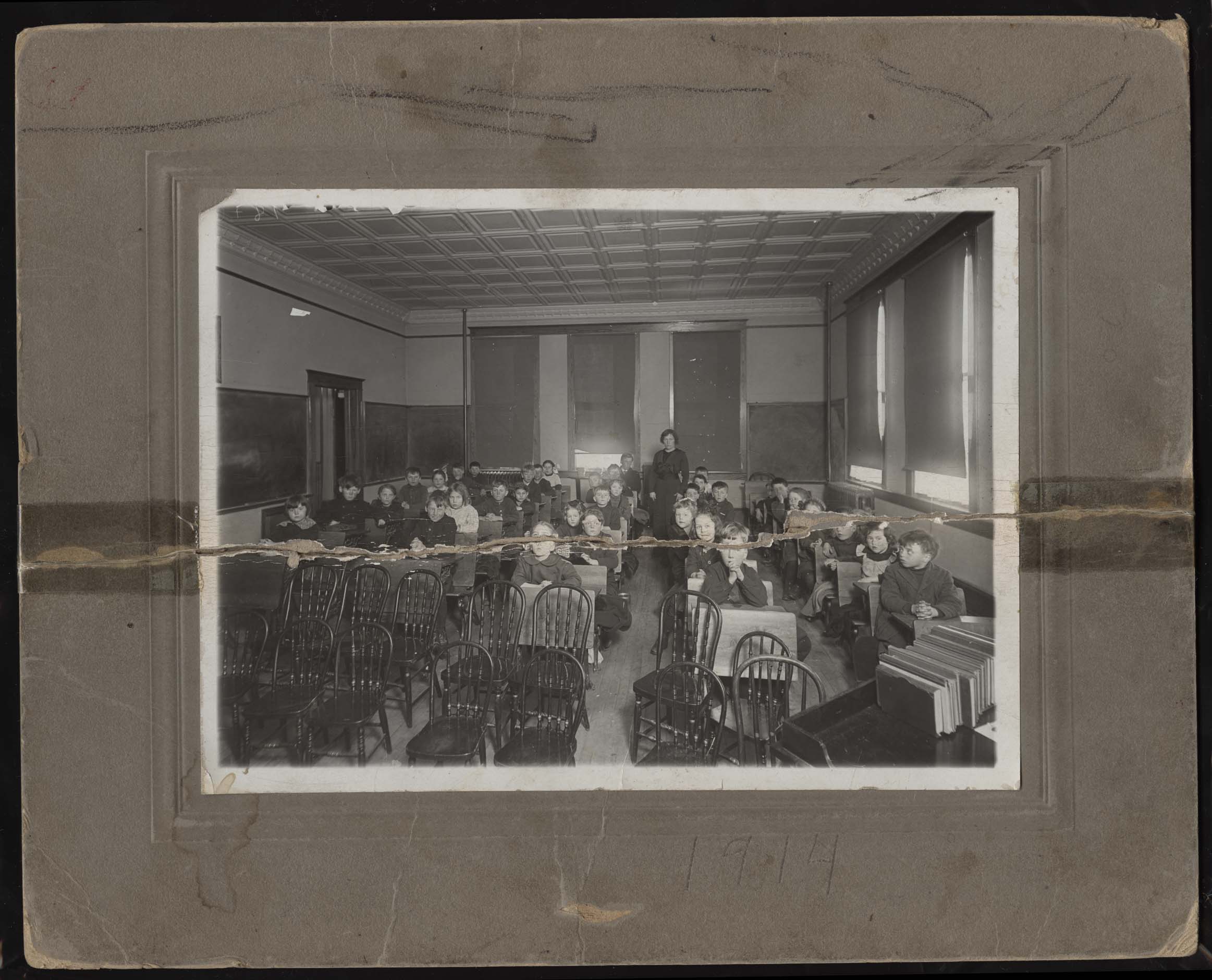
There are about 34 students in Mrs. Birland’s new Ambrose School classroom in 1914. The schoolroom is lit by windows, not electric ceiling lights. Each student has a desk, but there are chairs which students would use when moving up front to recite or read for the teacher. SHSND: 0213-12. |
| Source R | 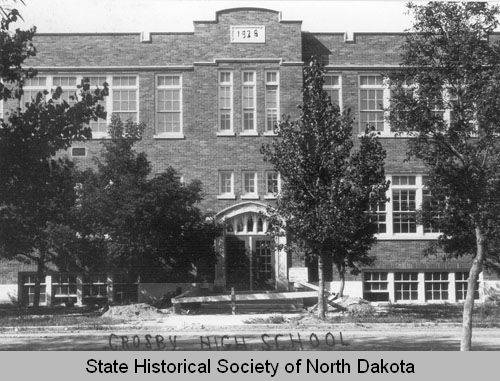
Crosby High School was built in 1928. This building was destroyed by fire in 1971. SHSND: 2009-P-02-01. |
| Source S | 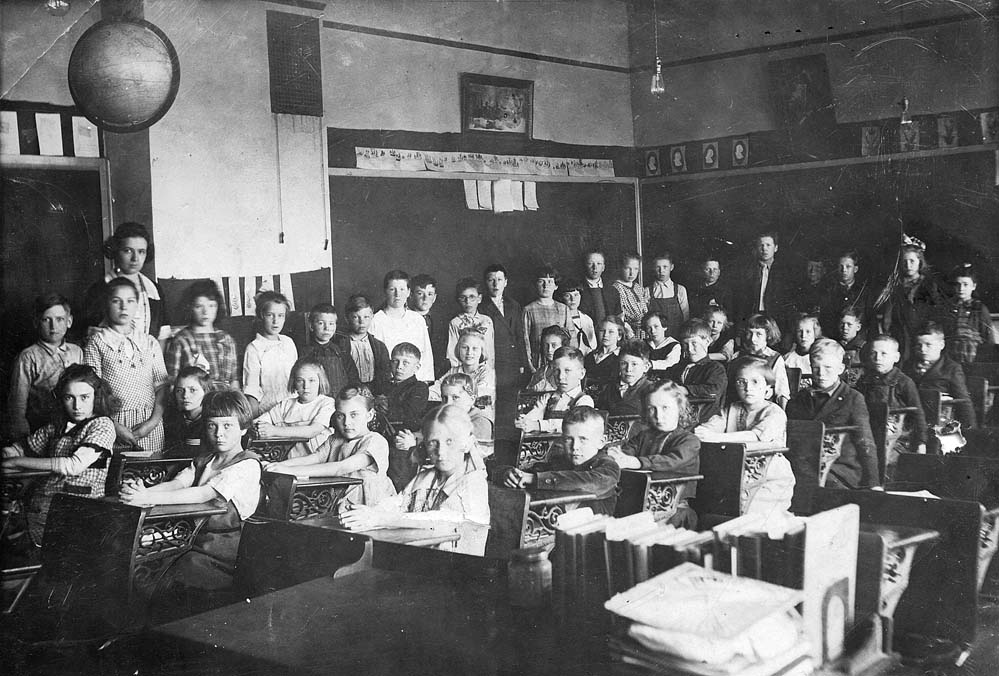
A grade school class in Crosby, ca. 1930. The 46 students in the photograph appear to represent several grade levels. Note the electric lights, the globe suspended from the ceiling, and the blackboards surrounding the classroom. SHSND: 2009-P-02-02. |


